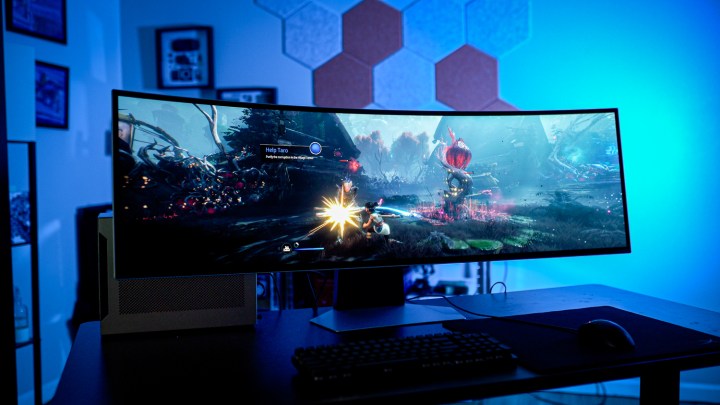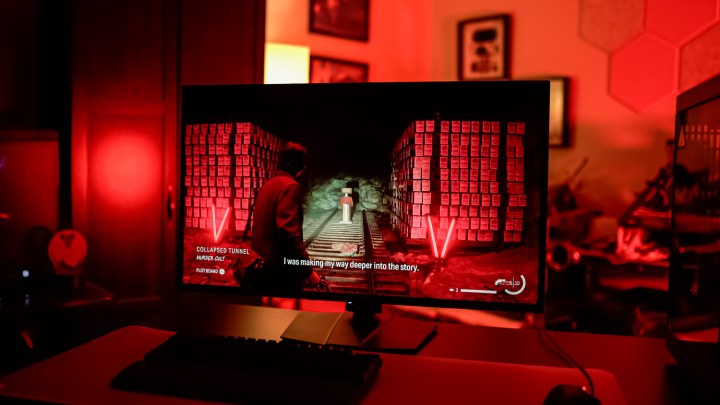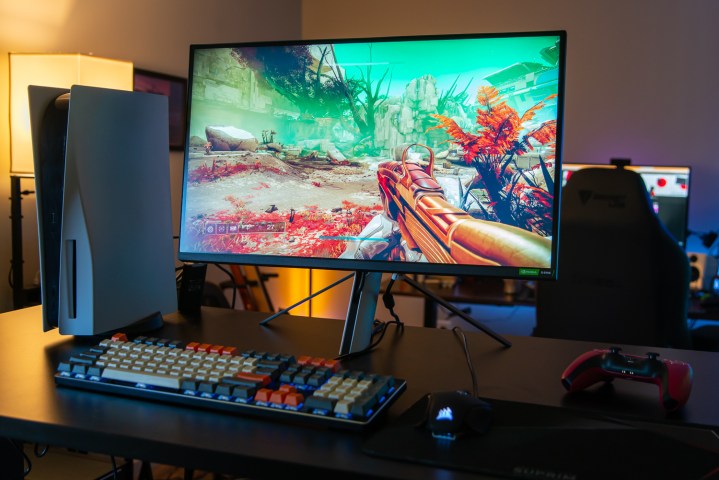OLED monitors are a waste of money, which is a shocking statement coming from the guy who packed the list of the best gaming monitors with OLED options. I love an OLED gaming monitor and the experience it can provide, don’t misunderstand me. For the vast majority of gamers, however, they’re simply too expensive to justify right now.
Since the release of the LG UltraGear OLED 27, we’ve seen a flurry of new gaming monitors sporting the latest and greatest panel tech. Each new release pushes the envelope further. Although we’re a few years separated from when the first OLED gaming monitors showed up, this display tech is still in its early adopter stage.
You’re literally wasting money

The 3423DWF version of the Alienware 34 QD-OLED launched at $1,100. It’s available as I write this for $750, and just a week ago, I found it for $600. These aren’t some back-alley deals, either. Those are the prices on Dell’s website where you can still buy the monitor. The Alienware 34 QD-OLED is two years old at this point, sure, but it’s not the only one. Samsung’s own Odyssey OLED G8 has dropped from $1,200 to just $800, and LG’s competing 34-inch OLED is also $800, down from the $1,300 it launched it.
It doesn’t take two years for prices to drop on OLED gaming monitors. In some cases, such as the Odyssey OLED G9, it happens in a matter of weeks. Prices always drop as products age, but we’re talking about price drops that completely change the buying decision. We’re talking about price drops of $400, $500, or even over $700. You can buy two Alienware 34 QD-OLEDs for the price you’d spend on one two years ago — and make no mistake, the Alienware 34 QD-OLED is still one of the best gaming monitors you can buy.
Those kind of aggressive price drops are indicative of a market that’s moving rapidly. Two years ago, it was the Wild West with the Alienware 34 QD-OLED arriving at $1,400. Last year, the UltraGear OLED 27 cemented $1,000 as the going rate for a 27-inch display with a 1440p resolution and 240Hz refresh rate. And this year, monitors like the MSI MPG 321URX have pushed 32-inch, 4K OLED monitors under $1,000 for the first time.

We’ve seen a flurry of new OLED gaming monitors over the past couple of years, and for good reason. LG, Samsung, Asus, Gigabyte, MSI, and many others are all trying to capitalize on the new trend. That means an endless stream of new models and stiff competition, with brands undercutting each other and marking down old models to clear the shelves for the latest and greatest.
I don’t think we’re headed to a point where OLED gaming monitors will be a budget option. Until we have some display tech that can usurp what OLED has to offer, it will remain the go-to panel type for premium gaming monitors. It’s clear that we haven’t hit the pricing floor yet, though. We’re still in an era where simply waiting a few months can mean saving hundreds of dollars on a new OLED monitor.
With those kinds of price drops on such a short timeline, it’s safe to say that buying a new OLED monitor is a waste of money. Things will eventually settle down, but at the moment, you’re paying a massive premium to be the first in the door with each new OLED gaming monitor.
Monitors move quickly

While the monitor world has been salivating over new OLED options, the monitor industry hasn’t been waiting idly. In particular, we’ve seen a crop of mini-LED monitors that have been pushing prices down. A few years ago, mini-LED was the gaming destination, with most displays arriving over $1,000. Now, you can pick up a premium mini-LED display for around $500, with some going for as little as $300.
The best showcase of how far mini-LED has come is the Sony InZone M9. This monitor is about two years old at this point, but it was shocking when it released. It arrived with 96 full array local dimming zones for $900, and it was the first showcase of a monitor that could handle an HDR image with local dimming under $1,000. By today’s standards, the InZone M9 seems insane. You can get mini-LED monitors for half the price with a much greater array of dimming zones.
For instance, the is a 27-inch 1440p display with a 165Hz refresh rate and 576 local dimming zones. You’ll spend $430 on that monitor. If you’re looking for something more premium, KTC offers a 4K mini-LED display with the same number of zones . And if you’re on a strict budget, you can pick up the 1440p for as little as $280.
There are still premium mini-LED monitors, but the options with below 1,000 dimming zones have dropped massively in price over the past couple of years. Compared to a standard IPS or VA monitor without a mini-LED backlight and no access to local dimming, you can get a massive upgrade in image quality for only a little extra money. And compared to OLED, you’re saving hundreds, even if you compare the price drops on older OLED displays.

I won’t pretend that mini-LED can match OLED when it comes to image quality. It can’t, and mini-LED has its own suite of issues when it comes to issues like blooming. OLED also boasts far lower response times compared to mini-LED displays, giving you better motion clarity, particularly at higher refresh rates. When you consider the price difference, however, mini-LED still has a place.
It has even more of a place considering the rapidly evolving prices of OLED gaming monitors. Now that mini-LED has been around for a few years, it’s at the point where manufacturers are pushing prices lower and lower while delivering the image quality that was considered premium not long ago. Mini-LED displays may not be able to match OLED, but they’re a massive improvement over the crop of gaming monitors we had just a few years ago.
The bell curve

With any new tech, there’s a bell curve of adoption. The early adopters spend the most money and endure the most problems, while the late-comers can score a bargain but miss out on whatever tech is rising up next. You want to be in the middle. You want to buy in when prices are low enough to justify, most of the problems have been fixed, and you still have plenty of time to enjoy new tech without salivating over what’s next on the horizon.
OLED is certainly on the uptick. It’s tech that’s pushing into the era of mainstream adoption, but it hasn’t reached that point yet. Mini-LED, on the other hand, has. If you have the cash to spare, OLED is the best gaming experience you can buy right now. There’s no doubt about that. Just know that you’re wasting some money to get a head start on a monitor that will undoubtedly be cheaper within a few months.
Services Marketplace – Listings, Bookings & Reviews
